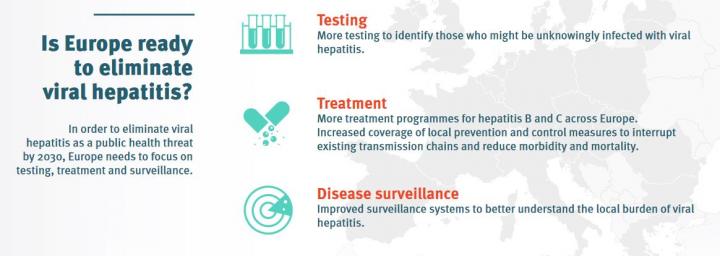
Credit: ECDC, European Centre for Disease Prevention and Control
During the annual session of the WHO Regional Committee for Europe in September 2016, the Member States adopted the European action plan for the health sector response to viral hepatitis. This is the first Action Plan for the Region and aims at guiding countries to achieve the set goal of eliminating viral hepatitis as a public health threat by 2030.
The Action Plan, as presented to the Regional Committee, provides regional milestones and targets across the continuum of viral hepatitis services and proposes priority actions for Member States.
Viral hepatitis in Europe
Currently, the countries of the European Union and European Economic Area report around 57 000 newly diagnosed acute and chronic cases of hepatitis B and C each year. And these figures most likely represent an underestimate of the true situation. Instead, it is believed that an estimated 10 million Europeans have chronic hepatitis B and C infection, most of them without knowing it as hepatitis is largely asymptomatic.
Data indicate a greater disease burden for hepatitis C compared with hepatitis B across Europe: numbers and notification rates for hepatitis C infection are nearly twice as high as those reported for hepatitis B. Read about recent data and trends here.
A systematic review on Hepatitis A virus (HAV) seroprevalence and Hepatitis A incidence in EU/EEA countries shows that although HAV circulation has been decreasing steadily over the past four decades, an increasing proportion of the EU/EEA population has become susceptible to HAV infection.
What's important to achieve elimination
This first European Action Plan provides an important driver to aid countries in their fight against viral hepatitis, to which ECDC had the opportunity to contribute directly. Currently, the available surveillance data show on-going transmission of hepatitis in Europe and in order to interrupt this chain and to prevent further infections, European countries need to strengthen local prevention and control practices as outlined in the plan.
To achieve elimination of viral hepatitis by 2030, European countries need to ensure that:
- those who might be unknowingly infected with viral hepatitis need to be identified through more effective testing and screening programmes;
- treatment programmes and coverage of local prevention and control practices (e.g. harm reduction, vaccination, prevention of mother-to-child transmission) are scaled up to interrupt existing transmission chains and to reduce morbidity and mortality;
- national surveillance systems need to be improved to better reflect the local burden of viral hepatitis.
It is especially important that those most at-risk for hepatitis have easier access to testing, for example, people who inject drugs, men who have sex with men or migrants from countries where the prevalence viral hepatitis is high. As reaching and testing those at risk of infection is still a public health challenge across Europe, ECDC also backs the efforts of the European HIV-Hepatitis testing week.
In order to help countries assess the hepatitis disease burden, evaluate existing prevention and control strategies and to define epidemiological trends or transmission patterns, ECDC coordinates efforts to improve the EU-wide surveillance data for hepatitis A, B and C.
###
Read more on viral hepatitis on the ECDC website.
Media Contact
ECDC Press Office
[email protected]
46-858-601-678
@ECDC_EU
http://ecdc.europa.eu





